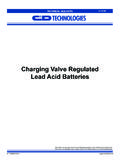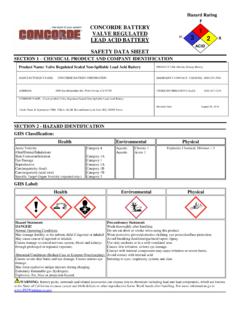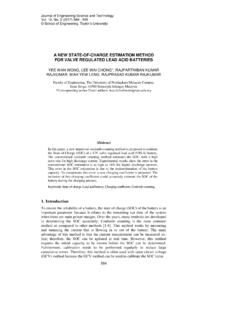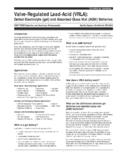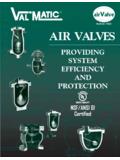Transcription of IEEE Recommended Practice for Maintenance, Testing, and ...
1 ieee Std 1188 -2005(Revision of ieee Std 1188-1996) ieee Recommended Practice forMaintenance, Testing, andReplacement of Valve-RegulatedLead- Acid (VRLA) Batteries forStationary ApplicationsI E E E3 Park Avenue New York, NY10016-5997, USA8 February 2006 ieee Power Engineering SocietySponsored by theStationary Battery CommitteeRecognized as anAmerican National Standard (ANSI) ieee Std 1188 -2005(Revision ofIEEE Std 1188-1996) ieee Recommended Practice for maintenance , Testing, and Replacement of Valve- regulated Lead- Acid (VRLA) Batteries for Stationary ApplicationsSponsorStationary Battery Committeeof theIEEE Power Engineering SocietyApproved 1 February 2006 American National Standards InstituteApproved 22 September 2005 ieee -SA Standards BoardThe Institute of Electrical and Electronics Engineers, Park Avenue, New York, NY 10016-5997, USAC opyright 2006 by the Institute of Electrical and Electronics Engineers, rights reserved.
2 Published 8 February 2006. Printed in the United States of is a registered trademark in the Patent & Trademark Office, owned by the Institute of Electrical and ElectronicsEngineers, : ISBN 0-7381-4796-6 SH95370 PDF: ISBN 0-7381-4797-4 SS95370No part of this publication may be reproduced in any form, in an electronic retrieval system or otherwise, without the priorwritten permission of the : This Recommended Practice is limited to maintenance , test schedules, and testing pro-cedures that can be used to optimize the life and performance of valve- regulated lead-acid (VRLA)batteries for stationary applications.
3 It also provides guidance to determine when batteries shouldbe : battery acceptance test, battery capacity text, battery performance test, battery servicetest, valve- regulated lead-acid (VRLA) batteryIEEE Standards documents are developed within the ieee Societies and the Standards Coordinating Committees of theIEEE Standards Association ( ieee -SA) Standards Board. The ieee develops its standards through a consensusdevelopment process, approved by the American National Standards Institute, which brings together volunteersrepresenting varied viewpoints and interests to achieve the final product.
4 Volunteers are not necessarily members of theInstitute and serve without compensation. While the ieee administers the process and establishes rules to promote fairnessin the consensus development process, the ieee does not independently evaluate, test, or verify the accuracy of any of theinformation contained in its of an ieee Standard is wholly voluntary. The ieee disclaims liability for any personal injury, property or otherdamage, of any nature whatsoever, whether special, indirect, consequential, or compensatory, directly or indirectly resultingfrom the publication, use of, or reliance upon this, or any other ieee Standard ieee does not warrant or represent the accuracy or content of the material contained herein, and expressly disclaimsany express or implied warranty, including any implied warranty of merchantability or fitness for a specific purpose.
5 Or thatthe use of the material contained herein is free from patent infringement. ieee Standards documents are supplied AS IS. The existence of an ieee Standard does not imply that there are no other ways to produce, test, measure, purchase, market,or provide other goods and services related to the scope of the ieee Standard. Furthermore, the viewpoint expressed at thetime a standard is approved and issued is subject to change brought about through developments in the state of the art andcomments received from users of the standard. Every ieee Standard is subjected to review at least every five years forrevision or reaffirmation.
6 When a document is more than five years old and has not been reaffirmed, it is reasonable toconclude that its contents, although still of some value, do not wholly reflect the present state of the art. Users are cautionedto check to determine that they have the latest edition of any ieee publishing and making this document available, the ieee is not suggesting or rendering professional or other servicesfor, or on behalf of, any person or entity. Nor is the ieee undertaking to perform any duty owed by any other person orentity to another. Any person utilizing this, and any other ieee Standards document, should rely upon the advice of acompetent professional in determining the exercise of reasonable care in any given : Occasionally questions may arise regarding the meaning of portions of standards as they relate to specificapplications.
7 When the need for interpretations is brought to the attention of ieee , the Institute will initiate action to prepareappropriate responses. Since ieee Standards represent a consensus of concerned interests, it is important to ensure that anyinterpretation has also received the concurrence of a balance of interests. For this reason, ieee and the members of itssocieties and Standards Coordinating Committees are not able to provide an instant response to interpretation requests exceptin those cases where the matter has previously received formal consideration.
8 At lectures, symposia, seminars, or educationalcourses, an individual presenting information on ieee standards shall make it clear that his or her views should be consideredthe personal views of that individual rather than the formal position, explanation, or interpretation of the ieee . Comments for revision of ieee Standards are welcome from any interested party, regardless of membership affiliation withIEEE. Suggestions for changes in documents should be in the form of a proposed change of text, together with appropriatesupporting comments. Comments on standards and requests for interpretations should be addressed to:Secretary, ieee -SA Standards Board445 Hoes LanePiscataway, NJ 08854 USAA uthorization to photocopy portions of any individual standard for internal or personal use is granted by the Institute ofElectrical and Electronics Engineers, Inc.
9 , provided that the appropriate fee is paid to Copyright Clearance Center. Toarrange for payment of licensing fee, please contact Copyright Clearance Center, Customer Service, 222 Rosewood Drive,Danvers, MA 01923 USA; +1 978 750 8400. Permission to photocopy portions of any individual standard for educationalclassroom use can also be obtained through the Copyright Clearance Attention is called to the possibility that implementation of this standard may require use of subjectmatter covered by patent rights. By publication of this standard, no position is taken with respect to theexistence or validity of any patent rights in connection therewith.
10 The ieee shall not be responsible foridentifying patents for which a license may be required by an ieee standard or for conducting inquiries into thelegal validity or scope of those patents that are brought to its 2006 ieee . All rights lead-acid (VRLA) batteries are playing an ever-increasing role in control and powersystems. In many cases, VRLA batteries are being substituted for vented lead-acid batteries. Their use isalso expanding into many other applications where their unique characteristics are desirable. Both gelledelectrolyte and absorbed electrolyte VRLA designs, covering a range of sizes and capacities, are nowavailable for use in many traditional and nontraditional battery applications.
